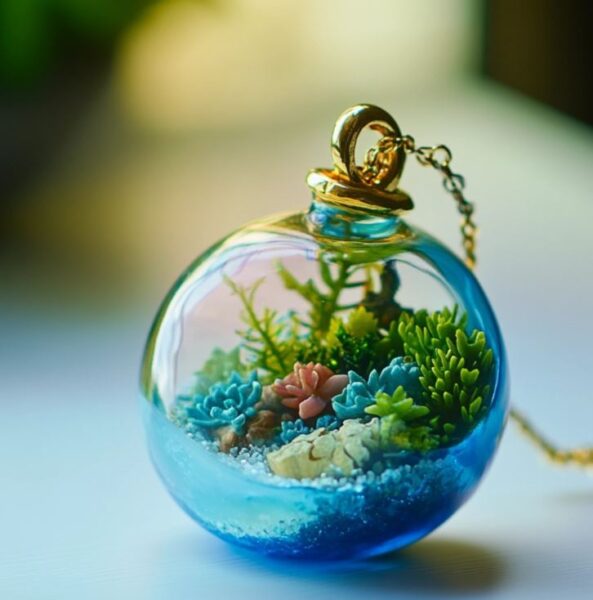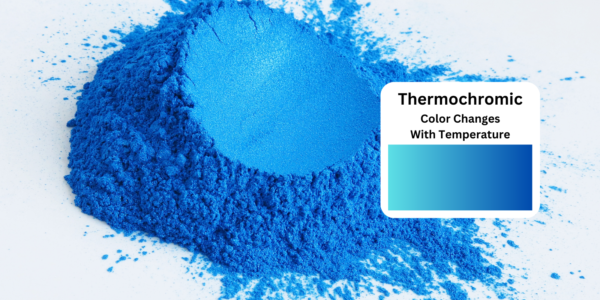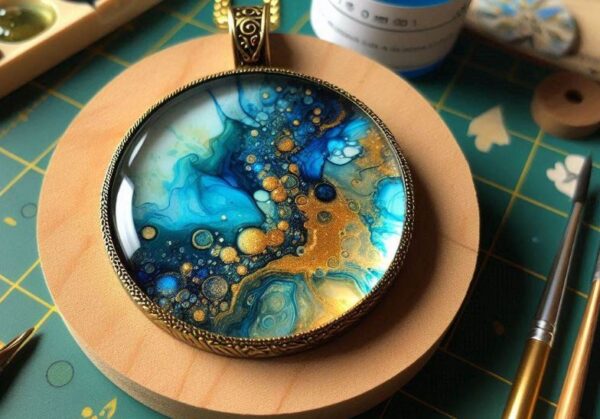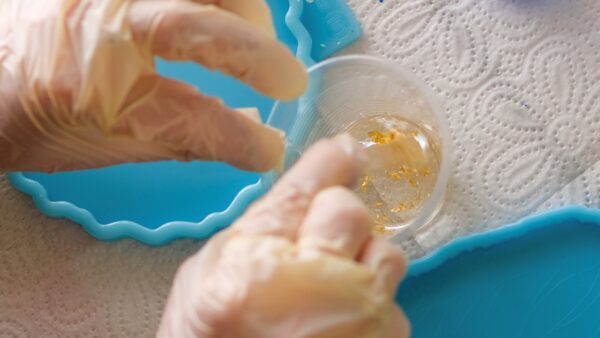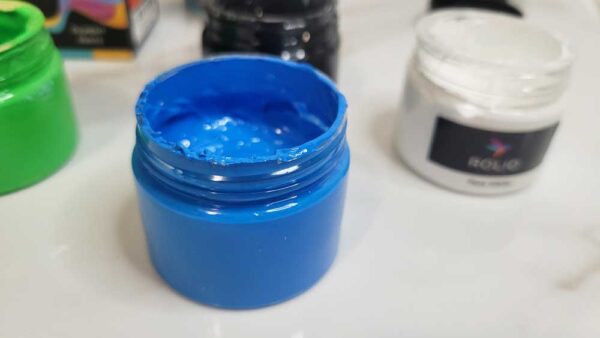How to Make Resin Earrings For Beginners ✅
Welcome to our step-by-step guide on crafting your own resin earrings. In this blog post, we’ll take you through the process, from gathering the necessary materials to learning how to make earrings with epoxy and UV resin.
Whether you’re a seasoned crafter or a beginner eager to explore the world of DIY jewelry, resin earrings provide a fantastic opportunity to express your unique style.
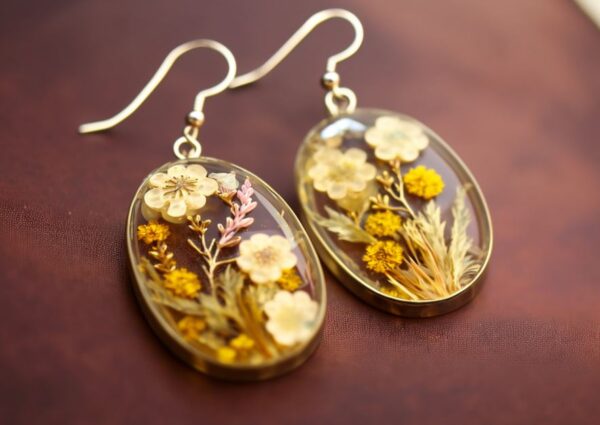
To get started, you’ll need a few key supplies. Make sure to gather high-quality resin, suitable molds, pigments for coloring, mixing cups, stirring sticks, and any additional embellishments you’d like to include in your designs.
See our article about how to use doming resin.
Having a well-organized workspace will make the crafting process smoother, so set up an area where you can comfortably work and let your creativity flow.
The key to successful resin earring crafting lies in knowing the basics first.
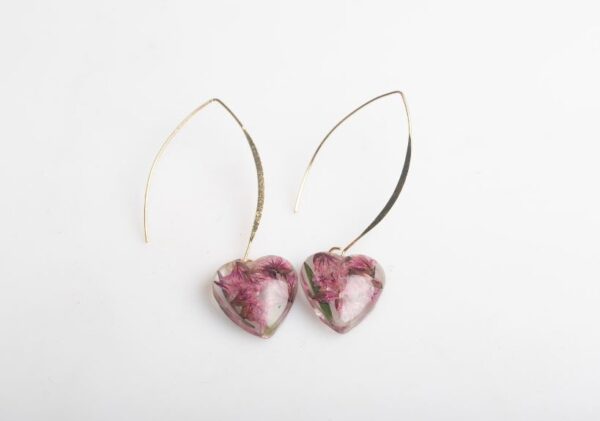
We’ll guide you through the precise measuring and mixing of resin, share tips on achieving the perfect color palette, and explore various techniques for creating eye-catching patterns and effects.
Understanding the curing process and proper demolding the resin techniques is also helpful so that your earrings turn out beautifully.
HOW TO MAKE RESIN EARRINGS GUIDE
1. Select the Right Earring Type
Crafting resin earrings begins with a thoughtful consideration of the earring type you want to create.
The style you choose—whether it’s the understated elegance of studs, the dynamic allure of dangles, or the timeless charm of hoops—lays the groundwork for your entire creative process.
Stud earrings, with their petite canvas, invite intricate designs and delicate patterns, making them ideal for those seeking a subtle yet personalized touch.
On the other hand, dangles and hoops offer more surface area, providing ample space for bold, vibrant, and eye-catching resin creations.
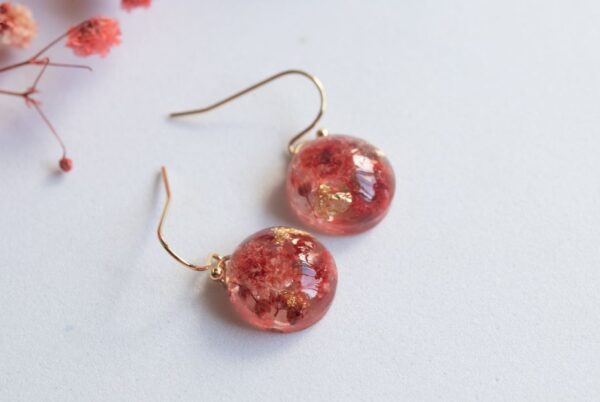
Your choice of earring type serves as the artistic framework upon which you’ll build your resin masterpiece, influencing subsequent decisions about design elements and materials.
Take a moment to envision the occasion or setting where your creations will shine. Consider your personal style preferences and the aesthetic you wish to convey through your earrings.
2. Gather High-Quality Resin
The backbone of any successful resin earring project lies in the choice of resin.
Opting for a high-quality resin specifically formulated for jewelry making is a pivotal decision that directly impacts the final outcome of your creations.
Look for a resin that has clarity, UV resistance, and excellent casting properties. The clarity of the resin is paramount, as it dictates the transparency of the earrings, allowing intricate details and vibrant colors to come to life.
This transparency not only enhances the visual appeal of your resin earrings but also contributes to the overall professionalism of the finished product.
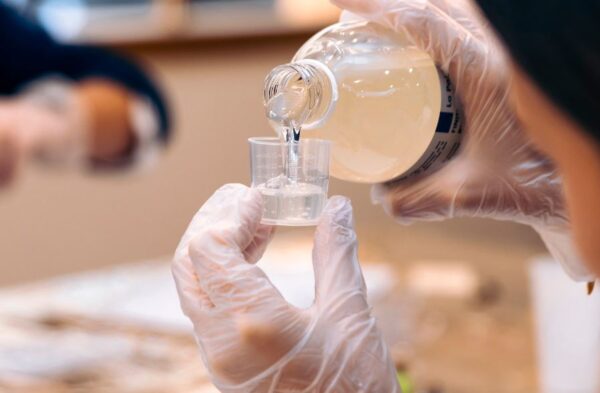
Pay attention to the curing time specified by the manufacturer, as this aspect not only affects the pace of your crafting but also influences the durability of the final earrings.
Investing in high-quality resin is an investment in the longevity and aesthetic integrity of your creations, ensuring that your handmade earrings withstand the test of time and daily wear while maintaining their captivating allure.
For making resin earrings you can use epoxy resin or UV resin. Both of these resins will work just fine to make resin earrings.
Or even go with a resin kit for beginners that has everything included.
3. Choose Suitable Molds
With the earring type and resin selected, the next crucial step is choosing suitable molds.
Molds play a pivotal role in determining the shape and dimensions of your resin earrings. Silicone molds are popular for their flexibility, making demolding a breeze, especially for intricate designs.
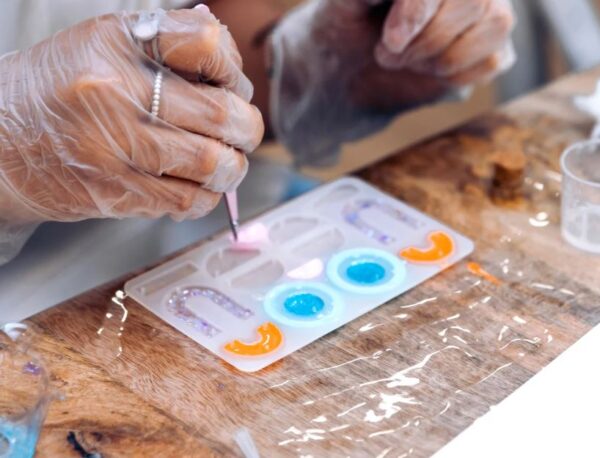
Alternatively, metal molds provide a different aesthetic and may be preferable for specific shapes.
Consider the intricacy of your design and the ease of releasing the cured resin when selecting molds. Having an assortment of molds in various shapes and sizes allows for diversity in your earring creations, enabling you to explore different styles and experiment with unique designs.
4. Prep Your Workspace
Creating resin earrings requires a well-organized and ventilated workspace. Set up your crafting area on a level surface to prevent uneven curing.
Have all your tools and materials within reach, including mixing cups, stirring sticks, molds, and any additional embellishments you plan to incorporate.
Adequate ventilation and wearing a resin respirator is crucial due to the fumes produced during the resin mixing and curing process.

Taking the time to prepare your workspace beforehand contributes to a seamless crafting experience, allowing you to focus on the creative aspects of the project without interruptions.
These initial steps, from choosing the right molds to preparing your workspace, lay the groundwork for a successful resin earring crafting experience.
See our resin safety guide before working with any type of resin.
5. Measure and Mix Precisely
Accurate measurement and thorough mixing of the resin and hardener are paramount for successful resin earrings.
Utilize graduated silicone mixing cups and adhere closely to the manufacturer’s instructions for the resin you’ve chosen.
Precision in measurement will help the proper chemical reaction and curing process of the resin, resulting in resilient and visually appealing earrings.

Take your time to stir the components thoroughly, paying attention to the edges and bottom of the mixing container to eliminate any streaks or unmixed portions.
This meticulous approach minimizes the risk of air bubbles in the resin, ensuring a crystal-clear finish for your resin earrings.
6. Add Pigments Thoughtfully
Infuse your resin earrings with a burst of color by experimenting with resin pigments.
Start with small amounts, as resin pigments can be highly concentrated. Mix the pigments thoroughly to achieve consistent and vibrant colors. You don’t want to go over about 10% or your resin might not cure properly or get resin dimples.
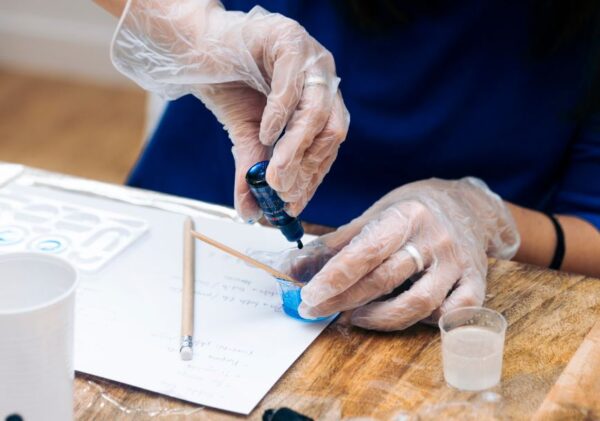
Before committing to your final design, conduct small tests until the desired hue is achieved, especially if you’re combining pigments to create custom colors.
Thoughtful and measured pigment addition allows you to fine-tune the visual appeal of your earrings, whether you’re aiming for subtle pastels or bold, eye-catching hues.
7. Incorporate Inclusions
You can add lots of different inclusions into resin such as glitter, dried flowers, or metallic flakes.
The key is to strike a balance—adding enough to enhance the design without overwhelming the overall aesthetic and causing your resin to seize up. One time I was mixing in some gold paint for resin and mixed in way to much. The whole batch seized up and I wasted so much money!
If you are using flowers, be sure that they are completely dried before using them in resin. We have a guide on the best ways to dry flowers.
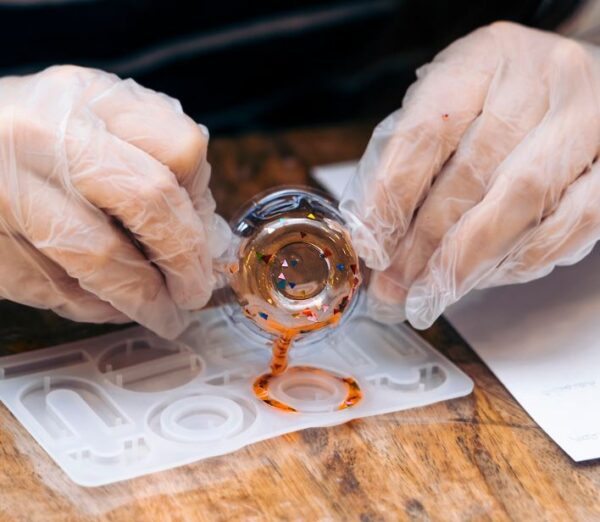
Consider the size and distribution of inclusions to achieve a harmonious look.
Whether you’re aiming for a touch of sparkle or a botanical charm, inclusions are a fun way to make your jewelry very different.
8. Master the Layering Technique
If your design involves multiple layers or colors, mastering the layering technique is crucial.
Allow each layer to cure completely before adding the next to prevent bleeding or blending of colors. This step-by-step approach gives crisp and distinct layers in your resin earrings, allowing you to create intricate patterns and captivating visual effects.
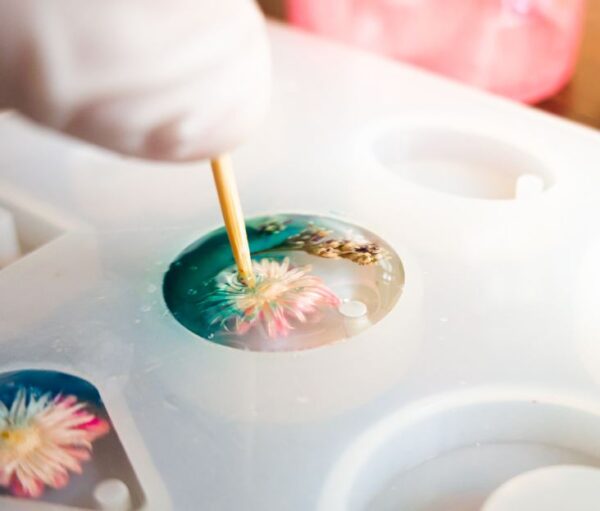
By paying attention to these details in the resin mixing and layering process, you’ll enhance the overall quality and aesthetic appeal of your earrings.
9. Use a Torch or Heat Gun for Bubbles
Achieving a clear finish in your resin earrings involves addressing air bubbles that may form during the mixing process.
A heat gun can be your best ally in this endeavor. Gently pass the flame over the surface of the resin before it starts to cure to pop any visible bubbles.
Take care not to overheat the resin, and maintain a steady hand for a smooth, bubble-free surface.
10. Use A Bubble Removal Machine
Using a bubble removal machine, such as a vacuum chamber or a pressure pot, can significantly enhance the quality of resin earrings by minimizing or eliminating air bubbles.

11. Follow Curing Time Guidelines
Patience is key when it comes to the curing process of resin earrings. Adhere closely to the curing time guidelines provided by the resin manufacturer.
Rushing this stage can compromise the integrity of the resin and result in a less durable final product.
Allow ample time for the resin to cure completely, ensuring that your earrings harden to their full potential.
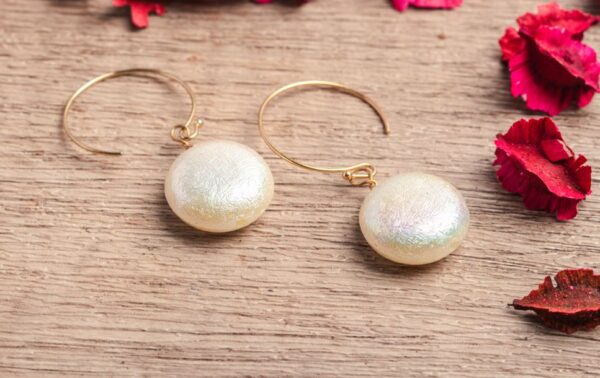
This patience will be rewarded with resilient, long-lasting resin earrings that maintain their aesthetic appeal over time.
If you would rather not have to wait for the resin to cure, then consider switching to a UV resin instead that uses a cure light to set the resin.
12. Careful Demolding
Once your resin earrings have completed the curing process, it’s time for the exciting step of demolding.
For silicone molds, gently flex the mold to release the cured resin without causing any damage.
If you’re working with more intricate molds, consider using a release agent to facilitate demolding.
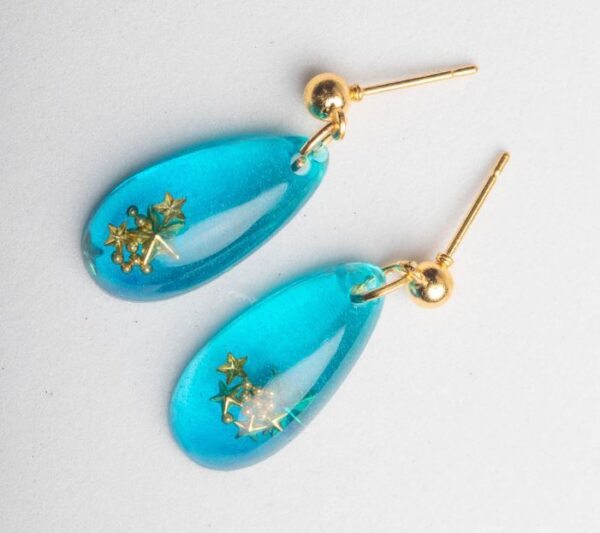
Take your time and exercise care during this step to preserve the intricate details of your resin earrings.
See our guide on how to get resin out of mold without tearing them.
13. Sand and Polish for Perfection
To achieve a polished and professional look, check for rough edges or imperfections in your resin earrings.
Lightly sand the edges using fine-grit sandpaper, working in gentle circular motions.
Follow up with a polishing step using a polishing compound or resin polish to restore the shine and clarity of the cured resin.
This attention to detail enhances the overall aesthetic of your earrings, transforming them into refined, wearable pieces of art.
Read our complete guide on how to polish resin.
14. Assemble Earring Components
With your perfectly crafted resin pieces in hand, the final step is assembling them into complete earrings.
Choose suitable findings such as earring hooks, studs, or hoops, and make sure you give them a secure attachment.
Pay attention to the balance and symmetry of the assembled earrings, and make any adjustments necessary for a cohesive and visually pleasing final result.

By giving equal consideration to the assembly process, you’ll guarantee that your resin earrings are not only aesthetically stunning but also durable and ready for everyday wear.
These comprehensive tips, from addressing air bubbles to the final assembly, guide you through the intricate process of creating resin earrings with precision and finesse.
Each step contributes to the overall quality and uniqueness of your handmade creations, transforming simple materials into personalized, wearable works of art.
15. Infuse Personal Touch and Experimentation
As you conclude the technical aspects of crafting resin earrings, don’t forget to inject your personal touch.
Experiment with different color combinations, inclusions, and layering techniques. This is the stage where you can truly let your creativity shine.
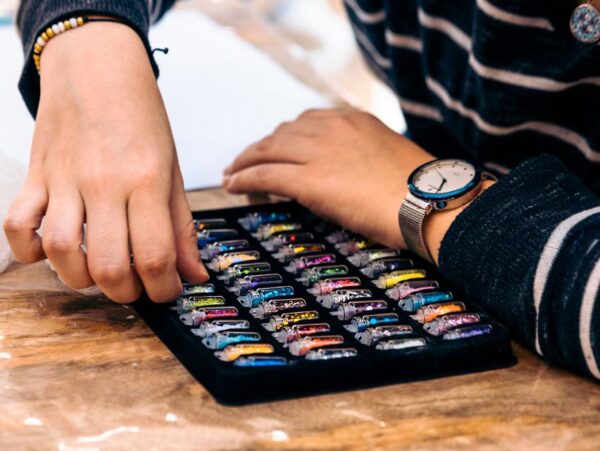
Whether you’re aiming for a set of earrings that subtly complement your style or ones that make a bold statement, experimenting with variations allows you to discover unique designs that resonate with your individual aesthetic.
16. Share and Seek Feedback
Once you’ve completed your resin earring creations, consider sharing them with the crafting community or seeking feedback from friends and fellow DIY enthusiasts.
Sharing your work not only provides a sense of accomplishment but also opens the door to constructive insights and ideas.
Others might be inspired by your designs, and their feedback can offer valuable perspectives to refine your technique or inspire your next project.
17. Document Your Process
Take a moment to document your resin earring crafting process. This could be through photographs, written notes, or even a video recording.
Documenting your journey not only serves as a visual diary of your creative process but can also be a helpful reference for future projects.

You may discover insights or techniques during this documentation process that enhance your skills and contribute to the evolution of your craft.
And always track how much you are spending, especially if you are planning to sell your resin earrings.
18. Store Earrings Properly
To preserve the beauty of your resin earrings, store them carefully. Consider placing them in individual pouches or compartments to prevent scratches or tangling.
Keep them away from direct sunlight and extreme temperatures to maintain the integrity of the resin.
Proper storage makes it so that your handmade earrings remain as stunning as the day you crafted them. Resin may yellow over time if not properly stored.
19. Embrace Continuous Learning
Resin crafting is a dynamic and evolving art form. Embrace a mindset of continuous learning by exploring new techniques, following updates in resin technology, and staying connected with the crafting community.
Attend workshops, join online forums, or participate in local crafting events to expand your skills and stay inspired. The world of resin crafting is vast, and there’s always something new to discover.
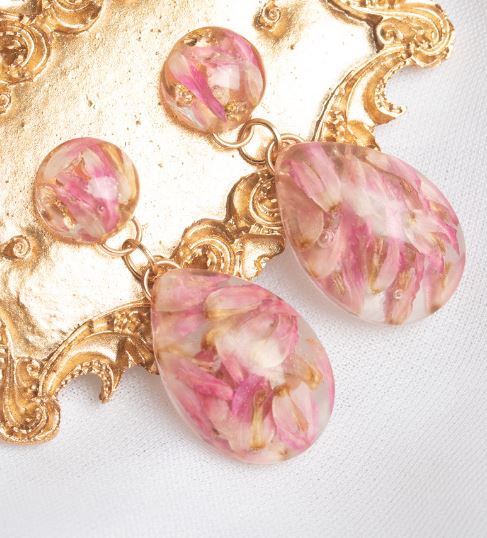
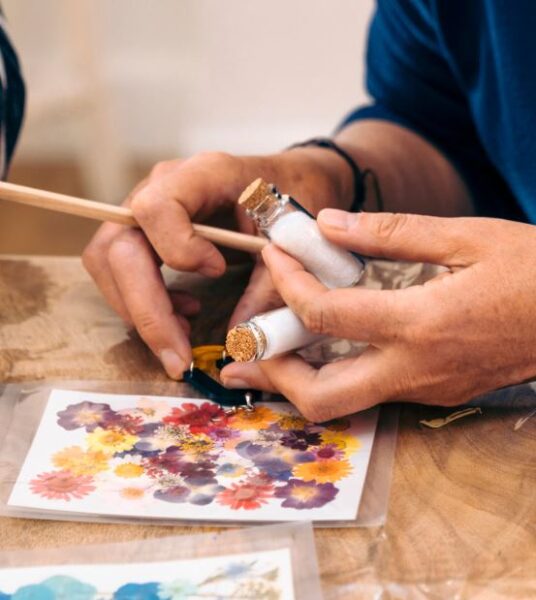
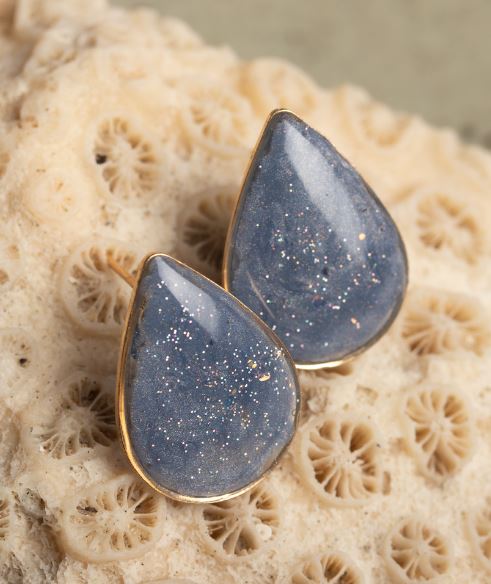
Resin earrings FAQ
1. What type of resin is best for making jewelry?
For jewelry making, it’s advisable to use clear, UV-resistant epoxy resin or UV resin. These resins are specifically formulated for small-scale projects, offer good clarity, and cure to a hard, durable finish ideal for jewelry.
2. How do I prevent air bubbles in my resin jewelry?
To prevent air bubbles, mix your resin and hardener thoroughly but avoid vigorous stirring that introduces air. Use a torch or heat gun to gently pass over the surface to pop any bubbles.
Mixing in a warm room and allowing the resin to sit briefly before pouring can also help. Or use a bubble removal machine like mentioned above.
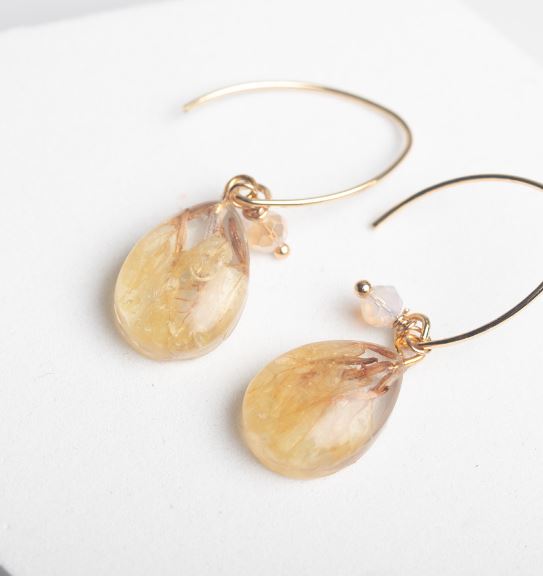
3. Can I add color to my resin jewelry, and how?
Yes, you can add color to resin using pigments or dyes specifically designed for resin. Add small amounts at a time and mix thoroughly to achieve the desired color. Experiment with different colors and ratios to create unique effects.
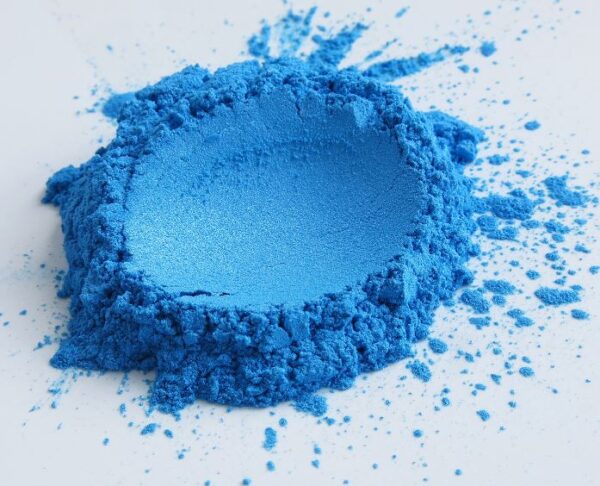
4. How long does it take for resin jewelry to cure?
The curing time varies depending on the type of resin used. Follow the manufacturer’s instructions for the specific resin you have, but generally, it can take anywhere from 24 hours to a few days for resin jewelry to fully cure. UV resin will cure in just a few minutes.
5. Can I embed objects in resin jewelry?
Absolutely! You can embed various objects like dried flowers, glitter, or small charms in resin. The objects must be thoroughly dry before embedding, and consider arranging them in layers for a dynamic effect.
6. How do I demold resin jewelry without damaging it?
For flexible silicone molds, gently flex them to release the cured resin. For more intricate molds, use a release agent before pouring the resin. Take your time and be patient during demolding to avoid damaging the details of your jewelry.
7. How can I achieve a glossy finish on my resin jewelry?
Sand the cured resin with fine-grit sandpaper to remove any imperfections, and then polish using a resin polish or a multi-step polishing compound. This process enhances the clarity and shine of the jewelry.
8. Can I resize or reshape resin jewelry after it has cured?
Once resin has cured, it becomes a rigid material, making resizing or reshaping challenging. Plan and execute your design precisely before the curing process. That’s why a planner or journal helps.
9. How should I store my resin jewelry?
Store resin jewelry in a cool, dry place away from direct sunlight. Consider placing individual pieces in pouches or compartments to prevent scratches.
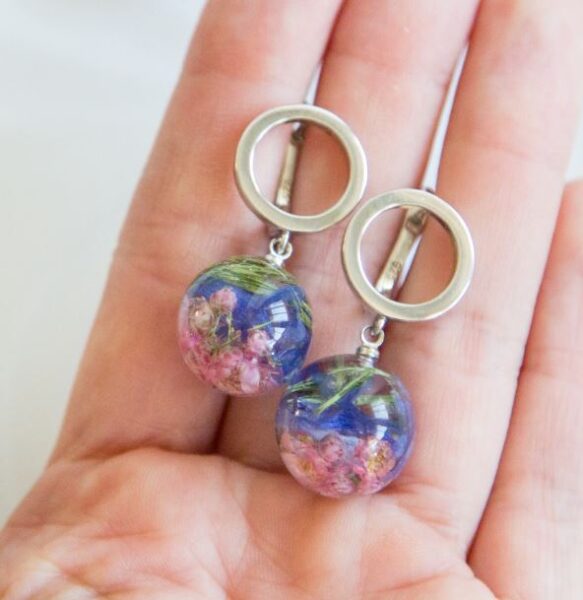
10. Can I wear resin jewelry in water?
While cured resin is water-resistant, prolonged exposure to water may affect its longevity. It’s best to remove resin jewelry before swimming or bathing to maintain its appearance over time.
Two Best Resins For DIY Earrings
1. Epoxy Resin
- Pros: Epoxy resin is known for its clarity, hardness, and UV resistance. It’s a popular choice for jewelry making due to its ability to create a glass-like finish.
- Cons: Epoxy resin can be trickier to work with as it has a shorter working time and may require careful measuring and mixing.

2. UV Resin
- Pros: UV resin cures quickly when exposed to ultraviolet light, making it a convenient choice for small projects like earrings. It is also known for its clarity.
- Cons: UV resin may not be as heat-resistant as other types, and extended exposure to sunlight could cause yellowing.
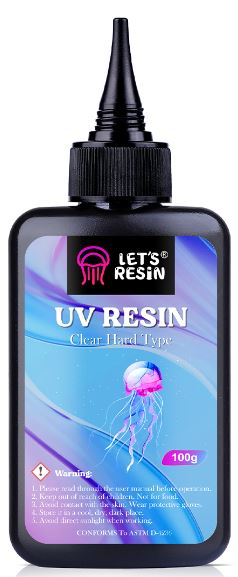
Check out our guide that goes deeper into the best resin for jewelry making.
In conclusion, creating resin earrings is not just a craft; it’s a journey of self-expression and artistic exploration.
By infusing your unique style, seeking feedback, documenting your process, and embracing continuous learning, you elevate your resin crafting experience from a project to a personalized and evolving artistic practice. Happy crafting!
Need more inspiration? Check out the best resin jewelry shops on Etsy.

